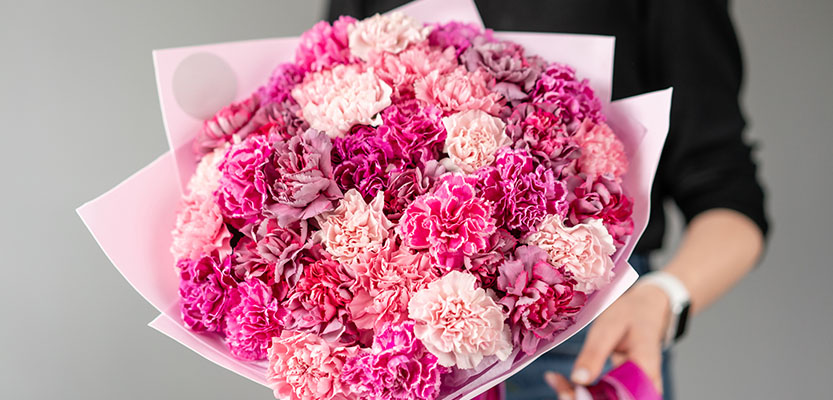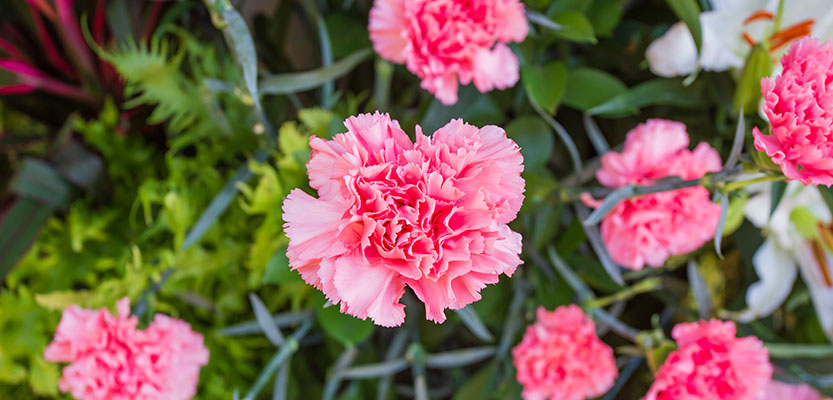Common Names:
- Carnation
- Clove Pink
- Sweet William (related species)
Scientific Name:
- Dianthus caryophyllus
Family & Genus:
- Family: Caryophyllaceae
- Genus: Dianthus
Description:

Carnations are characterized by their frilly, ruffled petals that come in a wide variety of colors, including white, pink, red, yellow, and purple. Some varieties are bicolored or have contrasting edges, adding to their visual appeal. The flowers grow on long, slender stems, making them ideal for bouquets and arrangements. They are also known for their clove-like fragrance, which adds a sweet and spicy note to their charm. Carnations are versatile, appearing in both compact and large-flowered varieties.
Habitat & Origin:
Native to the Mediterranean region, Carnations have been cultivated for over 2,000 years. They thrive in well-drained soil with full sun and moderate watering. These flowers are hardy and adaptable, growing well in gardens, greenhouses, and even as potted plants.
Symbolism & Meaning:
- Love and Admiration: Carnations are often associated with deep emotions of love and admiration, making them popular in romantic gestures.
- Motherhood: Pink carnations are the traditional flower of Mother’s Day, symbolizing a mother’s undying love.
- Fascination and Distinction: The uniqueness of their appearance conveys fascination and individual distinction.
- Grief and Remembrance: White carnations are often used in funerals to symbolize purity and remembrance.
Color Symbolism:
- Red: Passionate love and affection.
- Pink: Gratitude and admiration.
- White: Purity, innocence, and good luck.
- Yellow: Disappointment or rejection (traditional meaning, though less common now).
- Purple: Capriciousness or whimsical nature.
Uses:
- Floral Arrangements: Carnations are widely used in bouquets, centerpieces, and boutonnieres due to their long vase life and variety of colors.
- Dyeing and Preservation: White carnations are often dyed to create vibrant, custom colors for specific events.
- Cultural and Religious Ceremonies: Carnations play a role in various cultural festivals and are used as offerings in religious rituals.
Flower Care:

Carnations are known for their exceptional vase life, often lasting up to two weeks. To extend their freshness:
- Remove leaves below the waterline.
- Cut stems at an angle before placing them in clean water.
- Replace the water every two days and recut the stems to improve water uptake.
Flowering Season:
Carnations bloom in late spring and early summer in natural outdoor settings. However, they are cultivated year-round in greenhouses, ensuring a constant supply for floral markets.
Varieties & Hybrids:
- Standard Carnations: Single large blooms per stem, ideal for arrangements.
- Spray Carnations (Dianthus barbatus): Multiple smaller flowers on each stem, often called “mini carnations.”
- Fringed Carnations (Dianthus superbus): Known for their deeply cut, fringed petals and strong fragrance.
- Garden Pinks (Dianthus plumarius): Compact varieties with vibrant colors, ideal for garden borders.
Interesting Facts:
- Carnations were one of the first flowers to be dyed artificially.
- They are the birth flower of January, symbolizing love and distinction.









